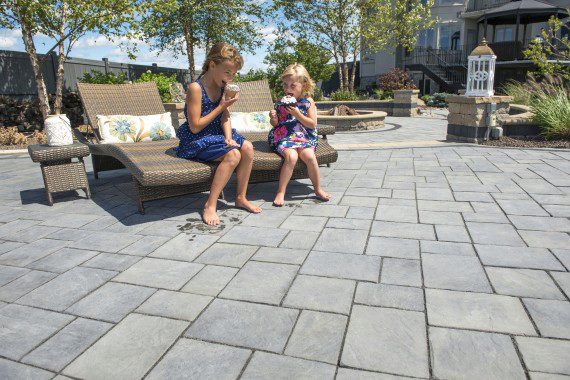Exploring the differences between concrete patio and paver patio options, this article delves into cost, durability, maintenance, and installation processes to help you make an informed decision for your outdoor space.
Concrete Patio vs. Paver Patio
When considering a patio for your outdoor space, two popular options are concrete and paver patios. Let's explore the key differences between the two to help you make an informed decision.
Cost Comparison
Concrete patios are generally more affordable upfront compared to paver patios. The cost of materials and installation for concrete is typically lower, making it a budget-friendly option for many homeowners.
Durability
Concrete patios are known for their durability and longevity. They can withstand heavy foot traffic and are resistant to weather conditions. On the other hand, paver patios may require occasional maintenance to prevent shifting or settling of the pavers.
Maintenance Requirements
Concrete patios are relatively low maintenance, requiring occasional cleaning and sealing to maintain their appearance. Paver patios, on the other hand, may need more frequent upkeep, such as re-leveling the pavers and replacing any damaged ones.
Installation Process
Installing a concrete patio involves pouring and leveling the concrete mixture, which then needs time to cure. In comparison, a paver patio is constructed by laying individual pavers in a pattern on a base of sand and gravel. While both processes require skill and precision, the installation of paver patios may take longer due to the intricate nature of laying the pavers.
Design Options
Concrete patios offer a great deal of design flexibility, allowing for various shapes, sizes, and finishes to suit different preferences and needs. On the other hand, paver patios provide a wide range of styles and patterns that can create unique and intricate designs for outdoor spaces.
Concrete Patio Design Options
Concrete patios can be customized in terms of shape, size, and texture. They can be stamped, scored, stained, or dyed to mimic the look of natural stone, brick, or even wood. This allows for a versatile range of design options to complement any home style or landscaping theme.
- Stamped Concrete: Offers a variety of patterns like cobblestone, slate, or brick.
- Scored Concrete: Allows for creating geometric designs or faux tile patterns.
- Stained or Dyed Concrete: Provides a wide array of color options to enhance the overall look.
Paver Patio Design Options
Paver patios come in various styles such as interlocking pavers, brick pavers, or natural stone pavers. These can be arranged in different patterns like herringbone, basket weave, or running bond, adding visual interest and texture to outdoor spaces.
- Interlocking Pavers: Easy to install and available in different shapes and sizes for unique designs.
- Brick Pavers: Classic and timeless look that can be arranged in traditional or contemporary patterns.
- Natural Stone Pavers: Provide a rustic and natural appeal with irregular shapes and textures.
Color Options
When it comes to color choices, concrete patios can be stained or dyed in a wide range of hues to match existing décor or create a focal point. On the other hand, paver patios offer natural color variations in materials like brick or stone, adding a touch of authenticity to outdoor spaces.
Enhance the Aesthetics
To enhance the aesthetics of a concrete patio, consider adding decorative elements like outdoor rugs, furniture, potted plants, or string lights to create a cozy and inviting atmosphere. For a paver patio, incorporating a fire pit, built-in seating, or a pergola can elevate the overall look and functionality of the outdoor space.
Environmental Impact
When deciding between a concrete patio and a paver patio, it is essential to consider the environmental impact of your choice. Both options have different sustainability aspects, drainage implications, and recyclability factors that can influence the overall impact on the environment.
Materials Used
Concrete patios typically require cement, sand, gravel, and water for construction. The production of cement, a key component in concrete, is known to have a significant carbon footprint due to the energy-intensive manufacturing process. On the other hand, paver patios are often made from natural materials like clay, stone, or recycled materials, which can be more sustainable options.
Drainage and Environment
Concrete patios are generally non-permeable, which means they can contribute to water runoff issues and poor drainage in the surrounding areas. This can lead to erosion, flooding, and pollution of water sources. In contrast, paver patios allow water to infiltrate the ground, promoting better drainage and reducing the risk of environmental damage.
Recyclability
Concrete is recyclable but may not be as easily recyclable as pavers, which can be reused or repurposed more efficiently. Pavers can often be salvaged and reused in other projects, minimizing waste and reducing the need for new materials. This aspect of recyclability can play a crucial role in minimizing the environmental impact of patio construction.
Longevity and Maintenance
Concrete patios and paver patios each have their own expected lifespan and maintenance requirements. Let's explore how to ensure the longevity of these outdoor surfaces.
Concrete Patio
- Concrete patios typically last around 25-30 years with proper care and maintenance.
- Common maintenance tasks for a concrete patio include regular cleaning with a pressure washer or mild detergent, sealing every 2-3 years, and addressing cracks promptly.
- To repair cracks in a concrete patio, you can use a concrete patching compound and sealant to prevent further damage.
- To prolong the lifespan of a concrete patio, avoid using de-icing chemicals in winter, place furniture on protective pads, and remove stains promptly.
Paver Patio
- Paver patios can last 30-50 years or more, depending on the quality of materials and installation.
- Maintenance tasks for a paver patio include regular sweeping to remove debris, occasional pressure washing, and resealing every 2-3 years to prevent staining and fading.
- If pavers become loose or settle over time, you can lift and level them using additional sand or gravel as needed.
- To extend the lifespan of a paver patio, avoid using harsh chemicals for cleaning, apply a sealant to protect against UV damage, and inspect for any signs of shifting or erosion.
Final Review
In conclusion, weighing the factors of design flexibility, environmental impact, longevity, and maintenance between concrete and paver patios is crucial in selecting the best option for your needs.
Clarifying Questions
What are the typical maintenance tasks for a concrete patio?
Maintenance for a concrete patio usually involves regular cleaning, sealing, and addressing any cracks or damages promptly.
How do color options differ between concrete and paver patios?
Concrete patios offer a wide range of color options through staining or integral coloring, while paver patios rely on the natural color variations of the stones.
Which is more environmentally friendly, a concrete patio or a paver patio?
Paver patios are considered more environmentally friendly as they allow for better drainage, reduced heat island effect, and easier recycling of materials.






